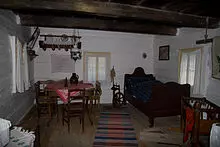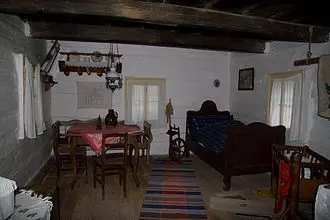 The art déco interior of the grand concourse at the 30th Street Station in Philadelphia
The art déco interior of the grand concourse at the 30th Street Station in Philadelphia
 The lobby of Hotel Bristol, Warsaw
The lobby of Hotel Bristol, Warsaw
 A historical example: Balliol College Dining Hall, Oxford
A historical example: Balliol College Dining Hall, Oxford
Interior design is more than just decorating a space; it is the art and science of enhancing the interior of a building to create a healthier and more aesthetically pleasing environment for the people who use the space. An interior designer is a skilled professional who plans, researches, coordinates, and manages enhancement projects to ensure they meet the needs and desires of the client. It is a multifaceted profession that encompasses conceptual development, space planning, site inspections, programming, research, communication with stakeholders, and the execution of the design[^1^].
History and Current Terms
 Typical interior of one of the houses in the Folk Architecture Reservation in Vlkolínec (Slovakia)
Typical interior of one of the houses in the Folk Architecture Reservation in Vlkolínec (Slovakia)
In the past, interiors were often designed instinctively as part of the building process[^1^]. However, the profession of interior design has evolved alongside the development of society and the complex architecture resulting from industrial processes[^1^]. The pursuit of effective use of space, user well-being, and functional design has contributed to the development of contemporary interior design[^1^].
Ancient cultures also recognized the importance of interior design. In ancient India, architects served as interior designers, incorporating sculptures and wall art paintings into their designs[^1^]. Similarly, ancient Egyptians placed "soul houses" in tombs as receptacles for food offerings, providing insights into the interior design of different residences throughout Egyptian history[^1^].
Throughout history, interior decoration was often the responsibility of the homemaker or employed upholsterer and craftsman[^1^]. However, as the middle class grew in size and wealth in the mid-to-late 19th century, interior design services expanded, leading to the emergence of professional interior designers in the mid-20th century[^1^].
Commercial Interior Design and Management
During the mid-to-late 19th century, the middle class's desire to display their newfound wealth led to the expansion of interior design services[^1^]. Large furniture firms began offering full house furnishings in various styles, competing with independent designers[^1^]. Eventually, independent designers, often amateurs, started taking over this role, leading to the professionalization of interior design in the mid-20th century[^1^].
 Illustrated catalog of the James Shoolbred Company, published in 1876
Illustrated catalog of the James Shoolbred Company, published in 1876
In the 1950s and 1960s, upholsterers expanded their business scope, framing it in artistic terms and targeting the public market[^1^]. To cater to the growing demand for interior work in commercial spaces, these businesses grew larger and more complex, employing various professionals to fulfill the job[^1^]. The emergence of department stores also played a significant role in popularizing interior design. These stores furnished retail spaces in different styles to attract customers, while model rooms showcased the latest trends at national and international exhibitions[^1^].
Transition to Professional Interior Design
 This interior was designed by John Dibblee Crace, President of the Institute of British Decorators, established in 1899.
This interior was designed by John Dibblee Crace, President of the Institute of British Decorators, established in 1899.
By the turn of the 20th century, the monopoly held by large retail companies on interior design was challenged by amateur advisors and publications[^1^]. These writings advocated for individuality in design, tailoring the style to the specific needs and preferences of the customer[^1^].
The formation of professional interior design organizations, such as the Institute of British Decorators in 1899, further contributed to the recognition of interior design as a distinct profession[^1^]. Gradually, the profession gained acceptance, and interior design became a recognized field requiring education and specialized knowledge[^1^].
Interior Decorators and Interior Designers
Interior design and interior decoration are closely related but distinct fields. Interior design emphasizes planning, functional design, and effective use of space, whereas interior decoration focuses on furnishing and adorning a space with decorative elements[^1^]. While interior designers can undertake projects involving the layout and technical aspects of a space, interior decorators do not have the same responsibilities[^1^].
 Interior design in a restaurant
Interior design in a restaurant
Interior designers must possess a high level of skill and knowledge to create functional, safe, and aesthetically pleasing environments[^1^]. They must understand building codes, regulations, and sustainable design principles, as well as coordinate with various professionals to ensure the successful execution of a project[^1^]. Interior design requires a creative approach and a comprehensive understanding of how people are influenced by their surroundings[^1^].
Color in Interior Design
Color plays a crucial role in interior design, allowing designers to create specific moods and evoke emotional responses[^1^]. A deep understanding of color psychology enables designers to select appropriate color palettes for different locations and situations[^1^]. Combining colors can make a room feel calm, cheerful, comfortable, stressful, or dramatic, while also influencing the perceived size of a space[^1^].
Specialties in Interior Design
 An electric wire reel reused as a center table at a Rio de Janeiro decoration fair
An electric wire reel reused as a center table at a Rio de Janeiro decoration fair
Interior design encompasses various specialties, catering to different types of spaces and clients[^1^]. Some common specialties include residential design, commercial design, hospitality design, healthcare design, exhibition design, and more[^1^].
The Profession of Interior Design
 Installment by L. Gargantini for the Bolzano fair, 1957.
Installment by L. Gargantini for the Bolzano fair, 1957.
Becoming a professional interior designer typically involves formal education and training[^1^]. Many universities offer degree programs in interior architecture and design, providing students with the necessary knowledge and skills to excel in the field[^1^]. Professional organizations like the American Society of Interior Designers (ASID) and the International Interior Design Association (IIDA) regulate the industry and promote excellence in design[^1^].
Interior designers work in diverse conditions and employment settings, ranging from large corporations to self-employment[^1^]. The job often involves meeting tight deadlines, staying on budget, and meeting clients' needs and preferences[^1^]. Licensed professionals may need to have their designs reviewed and stamped by structural engineers before approval[^1^]. Advances in technology have made client communication easier, reducing the need for extensive travel[^1^].
Styles in Interior Design
Art Deco
 Terracotta Art Deco sunburst design above front doors of the Eastern Columbia Building in Los Angeles; built 1930
Terracotta Art Deco sunburst design above front doors of the Eastern Columbia Building in Los Angeles; built 1930
Art Deco, which originated in Europe in the early 20th century, emphasized geometric shapes, clean lines, and metallic colors[^1^]. It embraced new technologies and materials, such as chrome, glass, stainless steel, and lacquer[^1^]. The style had a luxurious appearance, often featuring inlaid wood and reflective finishes[^1^]. Metallic colors, black and white, and vibrant color schemes were prevalent in Art Deco interiors[^1^].
Modern Art
Modern design, popularized during the mid-20th century, emerged from the decorative arts and featured clean lines and a focus on function and simplicity[^1^]. Frank Lloyd Wright was an early proponent of this style, and it reached its peak during the 1950s and '60s[^1^].
Arab Materials
 Majlis painting
Majlis painting
Majlis painting, also known as nagash painting, is a traditional decoration style in Arabic homes[^1^]. It features geometric designs and bright colors, reflecting the area's textile and weaving patterns[^1^]. Women often complete the decorative painting, showcasing their taste and knowledge of design[^1^].
Media Popularization
Interior design has become a popular subject for television shows, magazines, and radio programs[^1^]. Numerous TV shows, such as "60 Minute Makeover" and "Trading Spaces," showcase interior design and offer inspiration to viewers[^1^]. Magazines like "Dwell" and "Domino" cater to different design preferences, while radio shows provide advice and insights from interior designers[^1^].
 Ellen Mazur Thomson, author of Origins of Graphic Design in America, determined that professional status is achieved through education, self-imposed standards, and professional gate-keeping organizations.
Ellen Mazur Thomson, author of Origins of Graphic Design in America, determined that professional status is achieved through education, self-imposed standards, and professional gate-keeping organizations.
Interior design is a thriving profession, continuously evolving to meet the needs of an ever-changing world[^1^]. It encompasses creativity, technical expertise, and a deep understanding of human behavior in the built environment[^1^]. With its impact on people's well-being and the aesthetics of spaces, interior design plays a vital role in creating beautiful and functional environments for everyone to enjoy[^1^].
Notable Interior Designers
Throughout history, numerous interior designers have left their mark on this dynamic profession[^1^]. Some notable figures include Elsie de Wolfe, Frank Lloyd Wright, and Mary Douglas Drysdale, among many others[^1^]. Their contributions have helped shape the field and inspire future generations of designers[^1^].
Interior design is an art form that combines creativity, technical skills, and a deep understanding of human behavior in the built environment. It continues to evolve as society changes and new design trends emerge. Whether it's creating a cozy home, an inviting hotel lobby, or a functional office space, the work of interior designers enhances our daily lives and creates spaces that bring joy and inspiration.












